REALISM

The project REALISM (Reproducing Earthquakes in the Laboratory: Imaging, Speed and Mineralogy) proposes a simple idea: to reproduce earthquakes in the laboratory. Indeed, earthquakes being spectacular examples of uncontrollable catastrophes, the opportunity to study them under controlled conditions in the laboratory is a unique opportunity to further our understanding of earthquake source physics.
The aim of the project is interdisciplinary, at the frontiers between Rock Fracture Mechanics, Seismology, and Mineralogy. Its ultimate goal is to improve, on the basis of integrated experimental data, our understanding of the earthquake source physics. During laboratory earthquakes, by measuring all of the physical quantities related to the rupturing process, we are unravelling what controls the rupture speed, rupture arrest, the earthquake rupture energy budget, as well as the common role played by mineralogy. Our work aims at constraining seismological statistical laws (Omori law for foreshocks and aftershocks, Gutenberg-Richter of earthquake magnitude statistics) and producing an unprecedented data set on rock fracture dynamics at in-situ conditions. In the future, our work may also provide insights for earthquake hazard mitigation or opportunities to test seismic slip inversion and dynamic rupture modelling techniques.
The new experimental infrastructure we have installed at the Laboratoire de Géologie of ENS Paris is unique in the world, in such a way it can reproduce on relatively large rock samples the pressure, temperature and stress conditions of depths where earthquakes occur in the crust as well as in the upper mantle of the Earth, with never achieved spatio-temporal imaging resolution to this day. This will eventually open the door to a better understanding of all the processes happening under stress within the first hundreds of kilometres of the Earth.
REALISM is funded by the European Research Council.
Research Team
Experimental Facilities
Imaging
Speed
Mineralogy
Scientific publications & Outreach
Research Team
The research group involves three PhD. students, three post docs, a research engineer, and three permanent researchers as well as associated researchers and visiting scientists.
PhD students
- M. Samson Marty has started on 01/10/2016. Samson is making a breakthrough related to the quantification of damage related wave radiation, as well studying the self-similarity and the precursory phase of earthquake ruptures in the laboratory.
- M. Jérôme Aubry has started on 01/10/2016. Jérôme performed the first full energetic budget of earthquake budget, the role of plastic deformation and fluids on earthquake propagation.
- Mrs. Arefeh Moarefvand has started on 01/10/2018. Arefeh performs laboratory experiments to understand how phase transformations occur under non-hydrostatic stress conditions.
Post-doctoral researchers
- Dr. Thomas Ferrand was hired for a six months period from 02/02/2017 to 30/08/2017. He worked on the role played by dehydration reactions in the triggering of intermediate depth earthquakes. He also performed a field study of a fossil earthquake in Balmuccia, Italy.
- Dr. Blandine Gardonio was hired for two years and half on 01/04/2017. She is looking at the precursory phase of deep earthquakes (WP1&3), including the Mw 7.9 Ogazawara deep earthquake. She is also implementing modern seismology tools at the laboratory scale. Blandine has presented her results at prestigious conferences organized on the topic of deep earthquakes at College de France and the Royal astronomical Society of London.
- Dr. Julien Fauconnier was hired for three years on 01/10/2016. He has been working on an experimental development and thanks to his work, we can now measure seismic properties during deformation at conditions of the upper Earth mantle.
Lab. Manager
Dr. Julien Gasc, initially hired for two years on 01/02/2017 and now on a permanent position, is in charge of the developments in the laboratory and in particular of the new generation Paterson apparatus. Julien also works on the mechanics of deep earthquakes and mantle minerals, sometimes using fancy equipment at the synchrotron.
Associated researchers
- Dr. Alexandre Schubnel is the PI of the project.
- Dr. Harsha S. Bhat is co-supervising the PhD. of Samson Marty.
- Dr. Javier Escartin (IPGP) is co-supervising the PhD. of Jérôme Aubry.
- Dr. Loïc Labrousse (Sorbonne University) is co-supervising the PhD. of Arefeh Moarefvand.
- Dr. François X. Passelègue (EPFL Lausanne) is associated to the project.
- Mateo Acosta, a PhD. student of EPFL Lausanne, supervised by M. François Passelègue and Mrs. Marie Violay (prof. EPFL Lausanne) has performed experiments on our equipment. His PhD. study is partially associated to the project.
Visiting scholars/professors
Over the last two years and a half, a number of visiting scientists were hosted at ENS. They have constituted a pool of international experts from which the project has greatly benefitted. Amongst these: Timm John (Freie Universitat Berlin), Pamela Burnley (University of Nevada in Las Vegas), Eiichi Fukuyama (National Insitute for Earthquake Disasters Prevention), Paul Johnson (Los Alamos National Laboratories), Takahiro Hatano (Earthquake Research Institute, University of Tokyo), Yehuda Ben-Zion (University of South California), Shamita Das (University of Oxford).
Experimental Facilities
A new rock fracture apparatus to perform laboratory earthquakes
A form of new-generation Paterson press, a gas-medium tri-axial deformation apparatus named after his inventor Mervin Paterson, was installed at the ENS in November of 2018. This new state-of-the-art experimental device weighs several tons and took a week of effort to assemble. The first successful deformation test under high pressure and temperature conditions was performed early 2019. The original Paterson press is capable of generating confining pressures of up to 400 MPa and axial loads up to 100 kN on cylindrical samples with typical diameters of ~10 mm and lengths of ~20 mm. The new-generation used here was designed to host much larger samples (50 mm length and 25 mm diameter) but reach similar stresses (up to several GPa’s), implying much greater axial loads. Unlike the original Paterson, the vessel of the one installed at ENS is therefore framed in a structure rated for 1000 kN. The vessel was tested at confining pressures up to 700 MPa and certified for routine experiments at pressures (using Ar gas) of 400 MPa. The current temperature capability is 650 °C.
The first tests revealed very fine control upon displacement and strain rate during the experiment (monitored and recorded at 1 Hz). A first deformation experiment was carried out on Carrara marble at 400 °C, 100 MPa and strain rates ranging from ~3 × 10–5-2 × 10–4 s–1. The sample was shortened by ~15 %, until failure was observed.
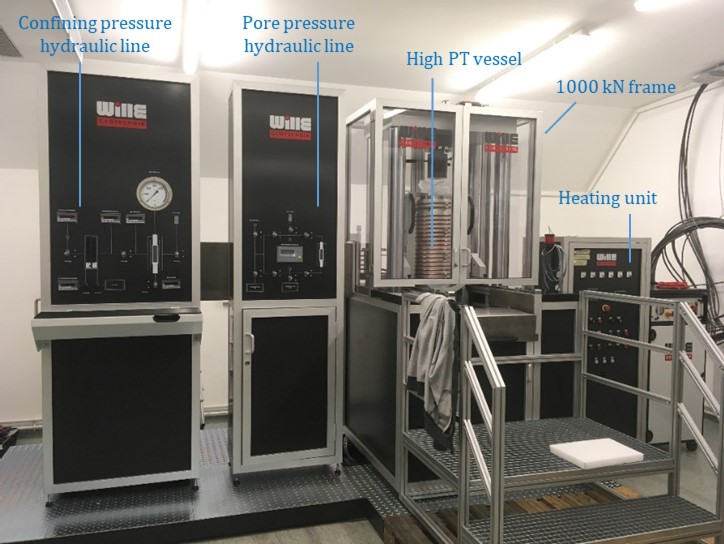
New-generation Paterson press and various units providing confining pressure, pore pressure and temperature
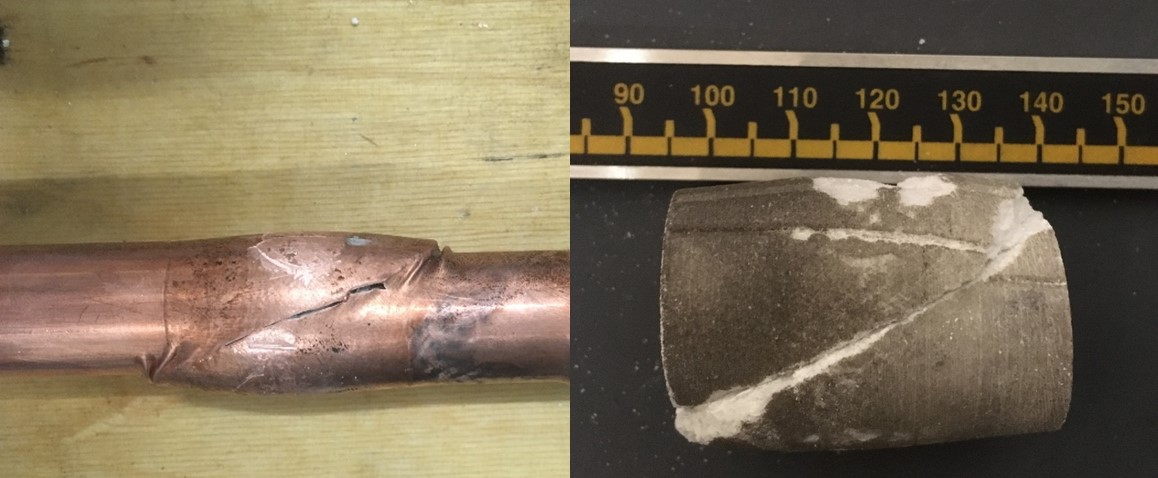
Left photo shows the Cu jacket containing the sample after the experiment. Right photo shows the same sample after recovery (removal of the Cu jacket). Sample has barreled and failed along a visible fault, thus showing evidences for both ductile and brittle deformation.
A new-generation Paterson press
with the participation of Wille Geotechnick, Bovi’s, ENS REALISM Team
Project manager : A. Schubnel – Film producer : J. Aubry
Imaging
Frictional heating, “asperities” and energy budget
The seismic efficiency of an earthquake is a measure of the fraction of the energy that is radiated away into the host medium. We estimated the first complete energy budget of an earthquake and show that increasing heat dissipation on the fault increases the radiation efficiency. We develop a novel method to illuminate areas of the fault that get excessively heated up. We finally introduced the concept of spontaneously developing heat asperities, playing a major role in the radiation of seismic waves during an earthquake.

Temperature maps during frictional sliding for three different confining pressures (from Aubry et al. GRL 2018)
Back-projection
Using acoustic recordings high-pass filtered, we applied at the laboratory scale an observation technique in seismology called “back-projection” to image, on the fault, zones of high-frequency energy release during rupture propagation. Our results showed that the high-frequency radiation originates behind the rupture front during propagation and propagates at a speed close to that obtained by our rupture velocity inversion. From scaling arguments, we suggested that the origin of high-frequency radiation lies in the fast dynamic stress-drop in the breakdown zone together with off-fault co-seismic damage propagating behind the rupture tip. The systematic application of the back-projection method at the laboratory scale provides new ways to locally investigate physical mechanisms that control high-frequency radiation.
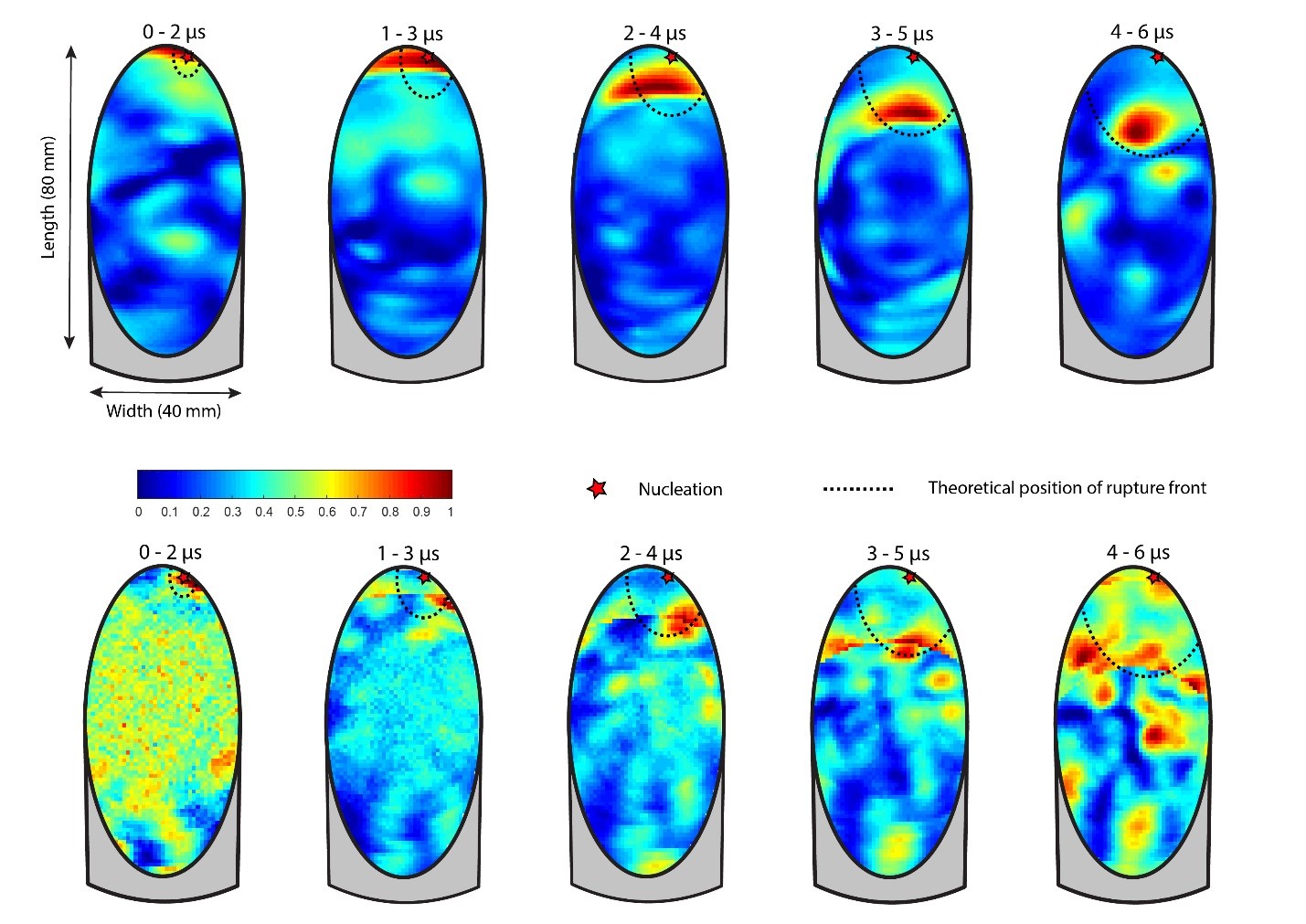
Snapshots of back-projection results for one stick-slip event at Pc = 90 MPa from acoustic waveforms highpass filtered (from Marty et al. GRL 2019)
Speed
Slow and fast ruptures in dolostones
A major part of the seismicity striking the Mediterranean area and other regions worldwide is hosted in carbonate rocks. Recent examples are the destructive earthquakes of L’Aquila 6.5 2016 in Central Italy. Surprisingly, within this region, fast (≈3km/s) and destructive seismic ruptures coexist with slow (≤10 m/s) and non- destructive rupture phenomena. We reproduced in the laboratory the complete spectrum of natural faulting on samples of dolostones representative of the seismogenic layer in the region. The transitions from fault creep to slow ruptures and from slow to fast ruptures, occurred at conditions encountered at 3-5 km depth (i.e., P = 100 MPa and T = 100°C) and is explained by the activation of flash weakening at asperity contacts which induce the propagation of fast ruptures radiating intense high frequency seismic waves.
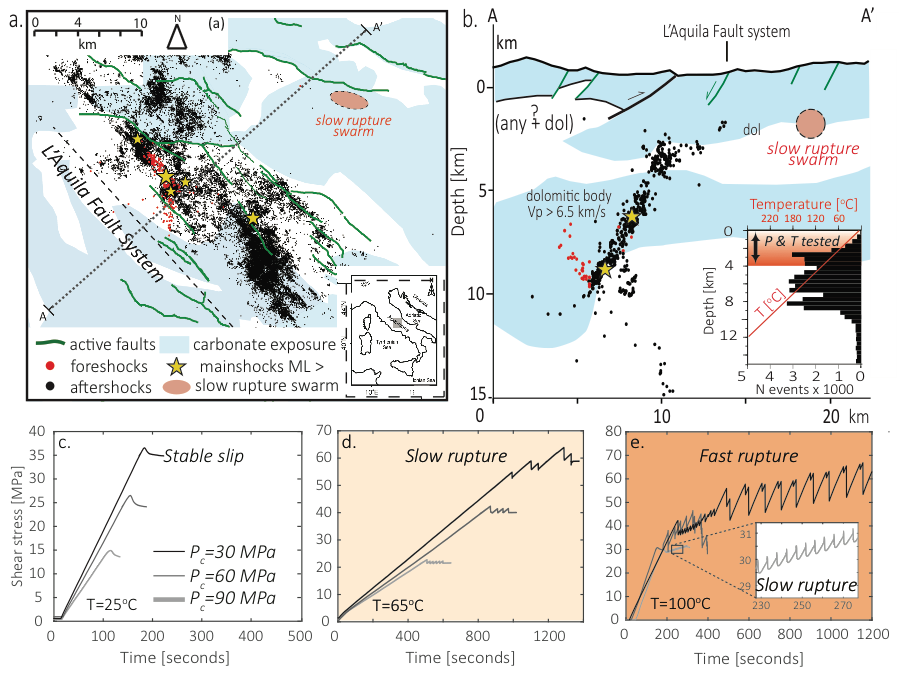
Seismicity distribution and laboratory reproduction of the L’Aquila 2009 sequence (from Passelègue et al. Geology 2019)
Fluid thermodynamics controls the seismic energy budget
Dry faults weaken due to degradation of fault asperities by frictional heating (e.g. flash heating). In the presence of fluids, theoretical models predict faults to weaken by thermal pressurization of fault fluid. However, experimental evidence of rock/fluid interactions during dynamic rupture under realistic stress conditions remained poorly documented. We demonstrated that the relative contribution of thermal pressurization and flash heating to fault weakening depends on fluid thermodynamic properties because water’s liquid–supercritical phase transition buffers frictional heat. The heat buffer effect has maximum efficiency at mid-crustal depths (~2–5 km), where many anthropogenic earthquakes nucleate.
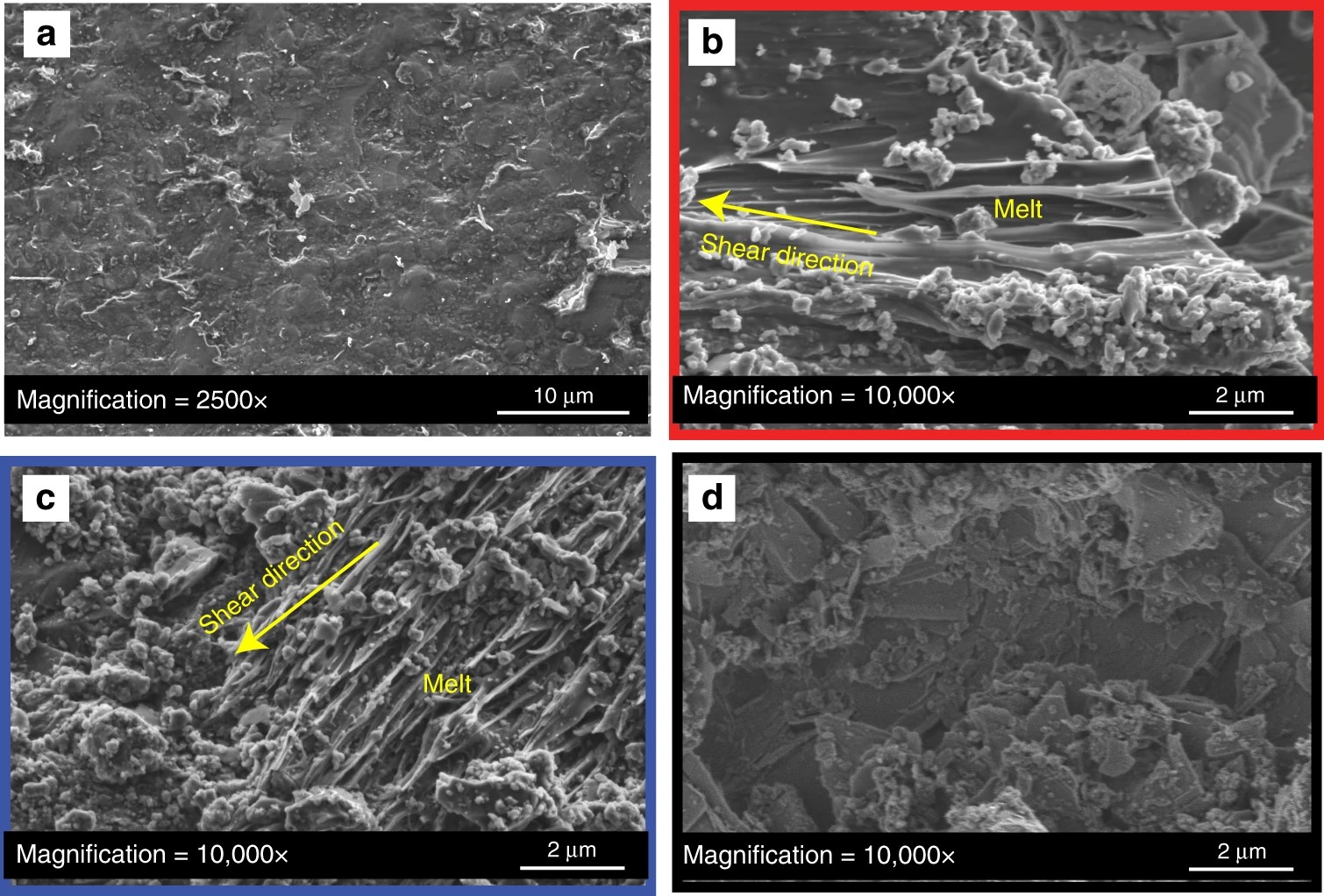
Micrographs of the fault’s surfaces – Scanning electron microscopic images under secondary electron mode of half-fault surfaces (from Acosta et al. Nat. Comm. 2018)
Mineralogy
Dehydration reactions and intermediate depth earthquakes
We deciphered the mechanism of intermediate-depth earthquakes (30–300 km) earthquakes by performing deformation experiments on dehydrating serpentinized peridotites (synthetic antigorite-olivine aggregates, minerals representative of subduction zones lithologies) at upper mantle conditions. Experimentally produced faults, observed post-mortem, were sealed by fluid-bearing micro-pseudotachylytes. Microstructural observations demonstrated that antigorite dehydration triggered dynamic shear failure of the olivine load-bearing network. These laboratory analogues of intermediate depth earthquakes demonstrated that little dehydration is required to trigger embrittlement. We proposed an alternative model to dehydration-embrittlement in which dehydration-driven stress transfer, rather than fluid overpressure, causes embrittlement.
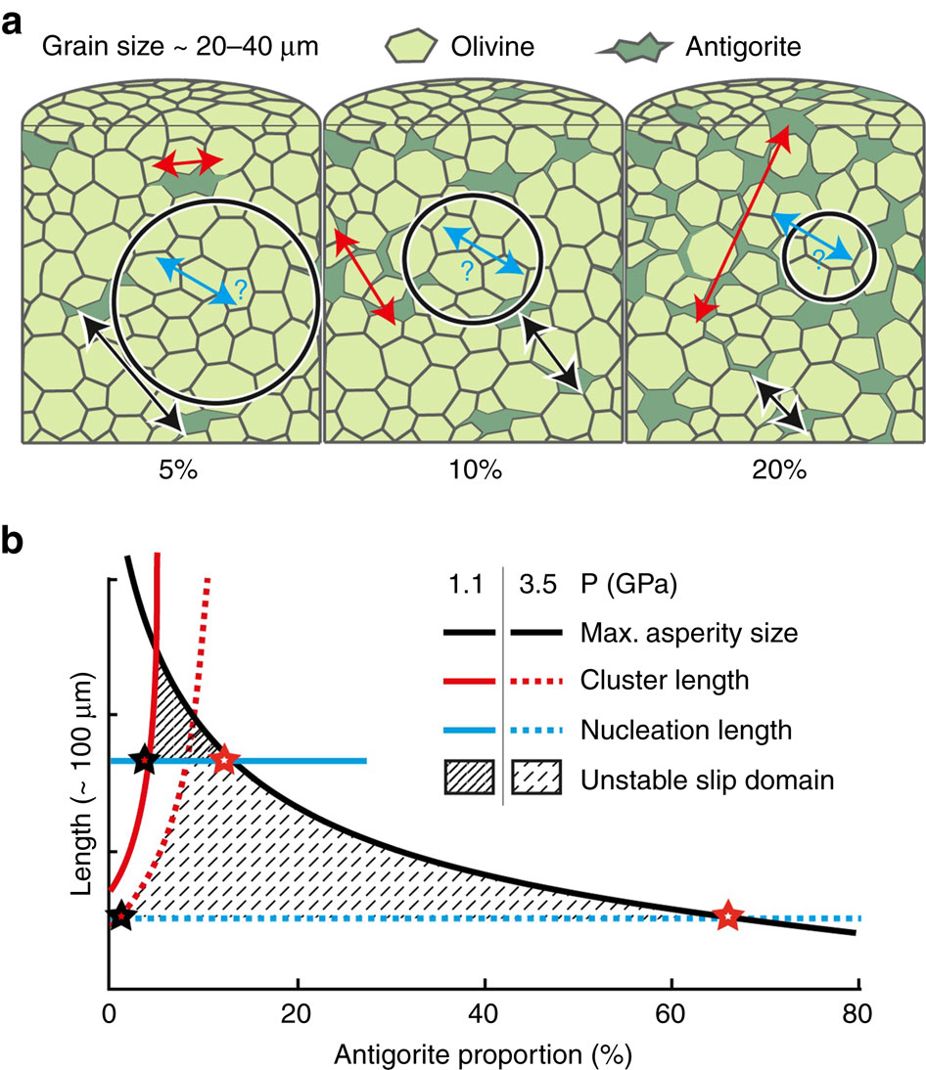
Conceptual model of dehydration-driven stress transfer faulting (from Ferrand et al. Nat. Comm. 2017)
Reproducing the deep seismicity under Tibet
Southern Tibet is the most active orogenic region on Earth where the Indian Plate thrusts under Eurasia, pushing the seismic discontinuity between the crust and the Earth’s mantle to an unusual depth of ~80 km. Numerous earthquakes occur in the lower portion of this thickened continental crust, but their triggering mechanisms remain enigmatic. Both field observations and geophysical data reveal a causal link between brittle seismic failure and eclogitization, a set of mineral phase transformations, of the lower continental crust. We demonstrate that mineral reactions lead to brittle deformation in situations where reaction rates are slow compared to the deformation rate. This work has been published in Geology in 2019.
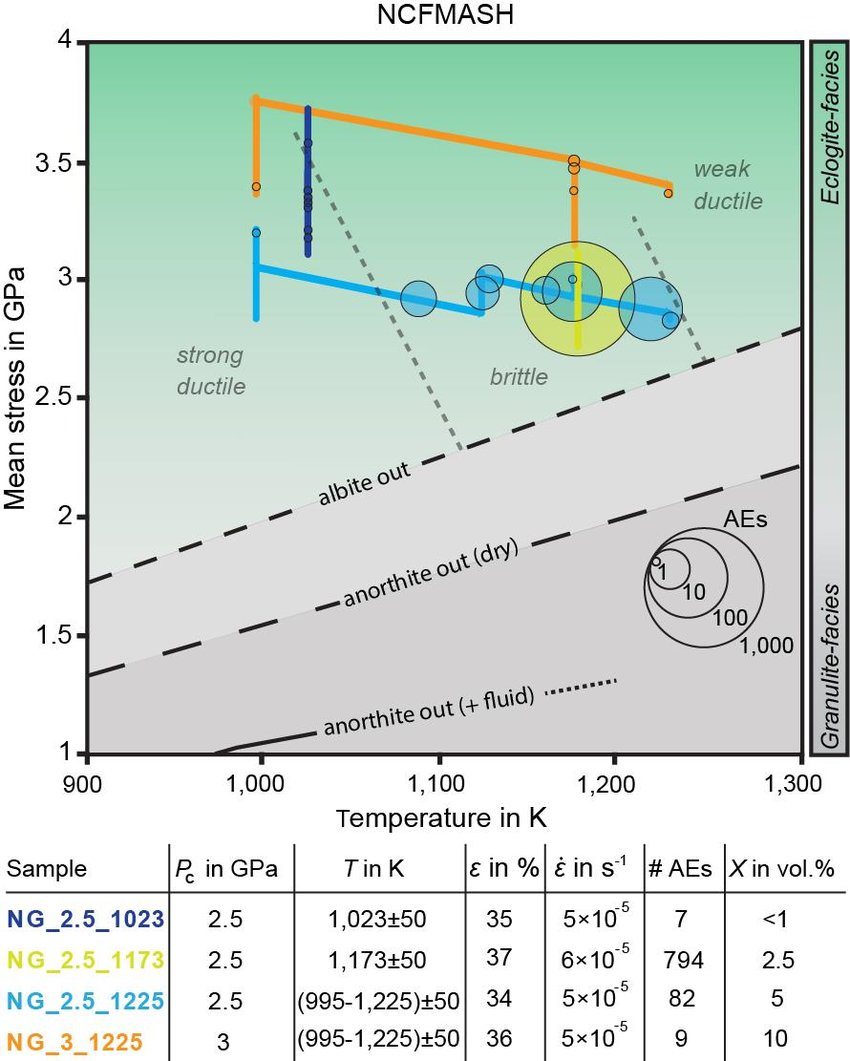
Mean stress-T curves on a P-T phase diagram showing the stability of plagioclase and table with the experimental conditions (from Incel et al. Geology 2019)
Publications & Outreach
Publication list as of 1/7/19
- Ferrand, Thomas P., Nadège Hilairet, Sarah Incel, Damien Deldicque, Loic Labrousse, Julien Gasc, Joerg Renner, Yanbin Wang, Harry W. Green II, and Alexandre Schubnel. « Dehydration-driven stress transfer triggers intermediate-depth earthquakes. » Nature communications 8 (2017): 15247.
- Aubry, J., F. X. Passelègue, D. Deldicque, F. Girault, S. Marty, A. Lahfid, H. S. Bhat, J. Escartin, and A. Schubnel. « Frictional heating processes and energy budget during laboratory earthquakes. » Geophysical Research Letters 45, no. 22 (2018): 12-274.
- Ferrand, Thomas P., Loïc Labrousse, Grégoire Eloy, Olivier Fabbri, Nadège Hilairet, and Alexandre Schubnel. « Energy balance from a mantle pseudotachylyte, Balmuccia, Italy. » Journal of Geophysical Research: Solid Earth 123, no. 5 (2018): 3943-3967.
- Acosta, Mateo, F. X. Passelègue, A. Schubnel, and Marie Violay. « Dynamic weakening during earthquakes controlled by fluid thermodynamics. » Nature communications 9, no. 1 (2018): 3074.
- Incel, Sarah, Loïc Labrousse, Nadège Hilairet, Timm John, Julien Gasc, Feng Shi, Yanbin Wang et al. « Reaction-induced embrittlement of the lower continental crust. » Geology 47, no. 3 (2019): 235-238.
- Shi, F., Wang, Y., Yu, T., Zhu, L., Zhang, J., Wen, J., Gasc, J., Incel, S., Schubnel, A., Li, Z. and Chen, T., 2018. « Lower-crustal earthquakes in southern Tibet are linked to eclogitization of dry metastable granulite. » Nature communications, 9(1), p.3483.
- Marty, S., F. X. Passelègue, J. Aubry, H. S. Bhat, A. Schubnel, and R. Madariaga. « Origin of high‐frequency radiation during laboratory earthquakes. » Geophysical Research Letters (2019).
- Passelègue, François X., Jérôme Aubry, Aurélien Nicolas, Michele Fondriest, Damien Deldicque, Alexandre Schubnel, and Giulio Di Toro. « From Fault Creep to slow and fast Earthquakes in Carbonates. » arXiv preprint arXiv:1901.06909 (2019).
- Okubo, Kurama, Harsha S. Bhat, Esteban Rougier, Samson Marty, Alexandre Schubnel, Zhou Lei, Earl E. Knight, and Yann Klinger. « Dynamics, radiation and overall energy budget of earthquake rupture with coseismic off-fault damage. » arXiv preprint arXiv:1901.01771 (2019).
- Acosta,Mateo, François X. Passelègue, Alexandre Schubnel, Raúl Madariaga, and Marie Violay. « Precursory moment release scales with earthquake magnitude. » arXiv preprint arXiv:1901.06908 (2019).
Outreach
- A book of fine art photography (The Fault, by Grégoire Eloy, RVB Books, 2017) was produced after the field study performed by Dr. Ferrand in Northern Italy.
- The PI, post-docs and students have been involved in outreach in junior high school of northern Paris, via the Fondation Arts et Sciences du 93, which promotes to bring scientists in contact with junior high schools students from impoverished neighbourhoods of the northern Paris area. This project is recurrent and each year, members of the group are involved.
- Alexandre Schubnel is involved in a Art, Science and Humanities interdisciplinary project on the Fukushima catastrophe. The project aims at bringing together Anthropologists, Sociologists, Scientists, and Artists in order to reflect on the Fukushima catastrophe.
- Homme de faille – arcticle by Lionel Charrier published in the newspaper Libération on August 22, 2019 on The Fault (cf. 1.) – also here.

